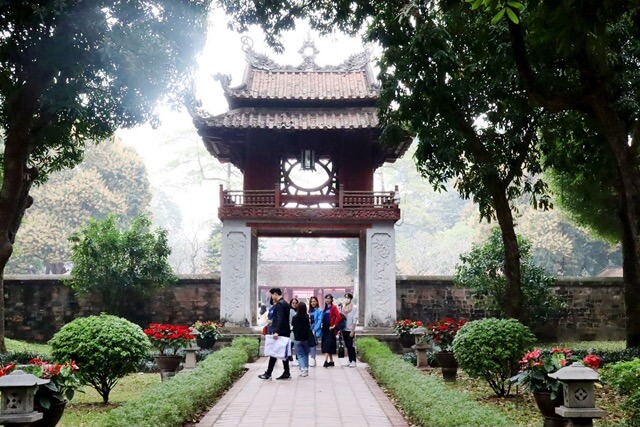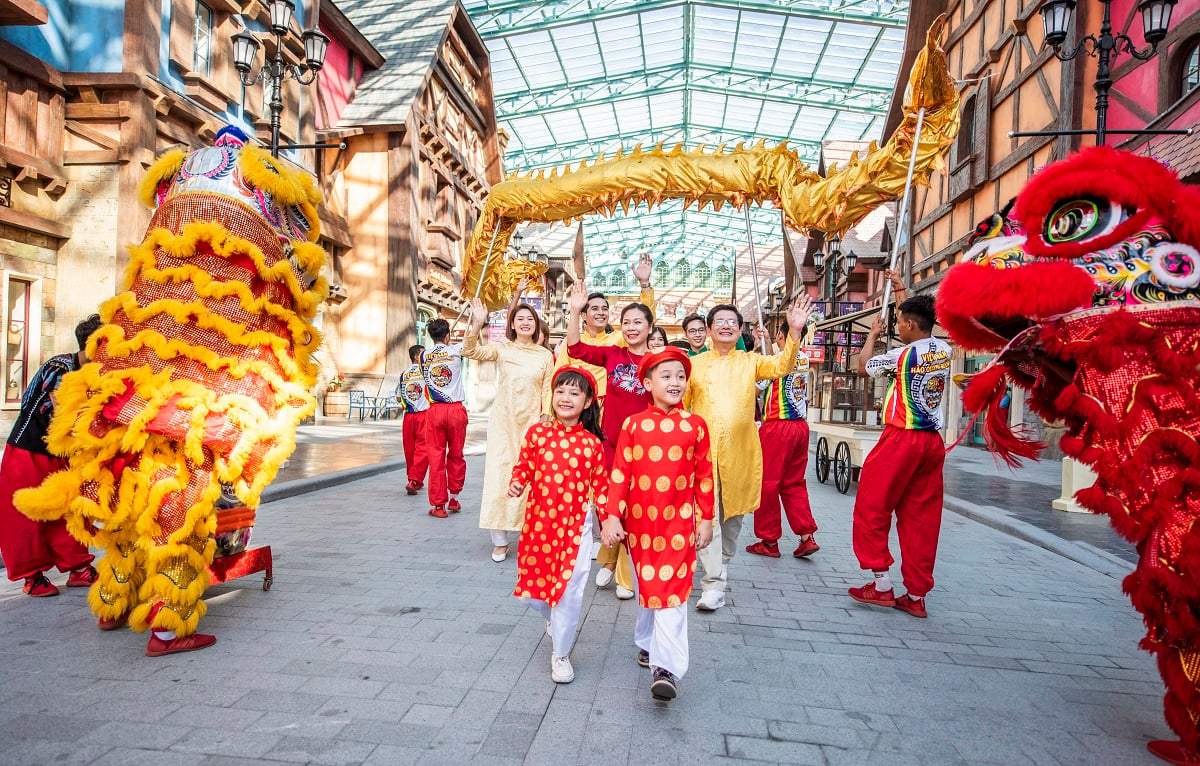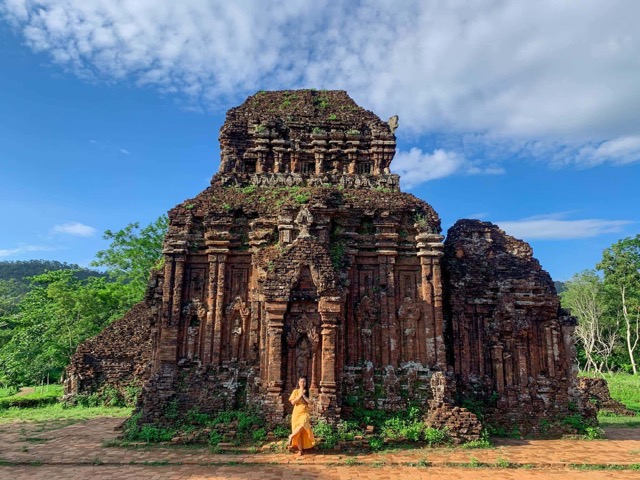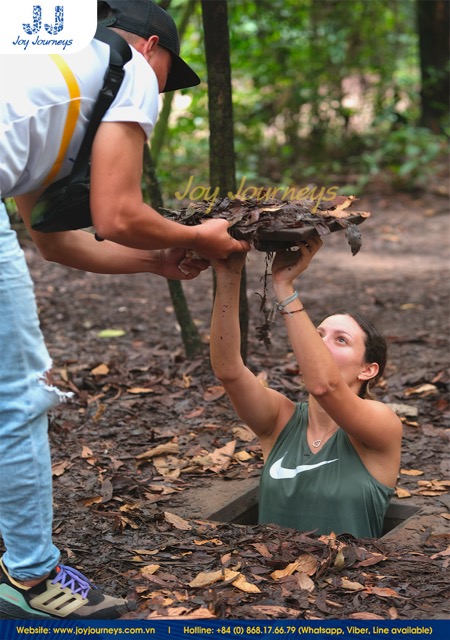Vietnamese Culture is a journey through rich heritage, traditions, and culinary delights. Embark on a captivating exploration of Vietnamese culture as we delve into its rich heritage, vibrant art scenes, and savory cuisine. From traditional dress and music to iconic dishes like Pho and Banh Mi, discover the essence of Vietnam Culture woven into every facet, promising visitors an unforgettable cultural experience.
Uncover the unique identity that defines Vietnam, inviting you to savor the flavors, immerse in traditions, and witness the artistic expressions that make this journey a celebration of Vietnamese culture.
Vietnam Travel: Discover the Best of Vietnam in Your Ultimate Travel Guide
Exploring Vietnam’s Essence
Vietnamese Coffee
Vietnamese coffee is a cornerstone of the country’s culture, renowned for its unique preparation and rich flavors.
The traditional method involves using a drip filter, allowing hot water to slowly pass through finely ground coffee beans, often accompanied by sweetened condensed milk. This iconic brew offers not just a caffeine fix but a sensory journey, reflecting the country’s leisurely pace and appreciation for quality.

Coffee shops, both bustling urban establishments and serene rural corners, provide spaces for socializing and contemplation, making the ritual of enjoying Vietnamese coffee a cherished daily experience.
Vietnam Fruits
The abundance of tropical fruits in Vietnam adds a burst of color and flavor to its culinary landscape. From the exotic dragon fruit and lychee to the familiar mango and banana, the country boasts a diverse array of fruits that thrive in its warm climate.

- Dragon Fruit (Thanh Long): Recognized by its vibrant pink or yellow skin with green scales, dragon fruit is not only visually stunning but also rich in antioxidants. Vietnam’s tropical climate provides the ideal conditions for this fruit to thrive.
- Mango (Xoài): Vietnam’s sweet and succulent mangoes are a tropical delight. Varieties like Cat Chu and Keo are celebrated for their juicy, flavorful flesh, reflecting the country’s favorable weather for mango cultivation.
- Lychee (Vải Thiều): Known for its sweet and fragrant taste, Vietnamese lychee is a tropical gem. The country’s warm temperatures contribute to the production of lychee with a distinctive floral aroma and a juicy, translucent texture.
- Durian (Sầu Riêng): Often referred to as the “king of fruits,” durian has a divisive reputation due to its strong odor. In Vietnam, the tropical climate allows durian trees to flourish, producing large, custard-like fruits that are loved by some and avoided by others.
- Pomelo (Bưởi): The large, citrusy pomelo thrives in Vietnam’s tropical climate. With a sweet and slightly tart taste, this refreshing fruit is enjoyed in various forms, from fresh segments to salads and juices.
- Jackfruit (Mít):Jackfruit, with its fibrous and sweet flesh, is a tropical delight in Vietnam. The country’s warm weather supports the growth of this massive fruit, often used in both savory and sweet Vietnamese dishes.
- Rambutan (Chôm Chôm): The hairy exterior of the rambutan conceals a translucent and juicy interior. Vietnam’s tropical conditions contribute to the abundance of rambutan during the fruiting season, offering a delightful treat for locals and visitors alike.
Exploring Vietnam’s essence is incomplete without savoring the succulence of its fruits, a delightful reflection of the country’s agricultural richness and commitment to fresh, seasonal produce.
Vietnamese Dishes
Vietnamese Culture Unveiled Through Culinary Delights. Renowned for its balance of flavors, fresh ingredients, and regional diversity, Vietnamese cuisine encapsulates the essence of the nation’s rich heritage. Let’s delve into some iconic traditional dishes that serve as a gateway to understanding and savoring the unique aspects of Vietnamese gastronomy.
- Phở (Pho): Vietnamese culture finds expression in the steaming bowls of phở, a hearty and aromatic noodle soup with delicate broth, rice noodles, and a choice of protein – typically beef (phở bò) or chicken (phở gà). Adorned with fresh herbs, bean sprouts, lime, and chili, phở embodies the spirit of communal dining and customization. Beyond its culinary allure, phở is a cultural symbol often enjoyed as a breakfast staple, fostering a sense of togetherness at street-side stalls and family-run eateries.

- Cơm Tấm: Cơm tấm, or broken rice, is a dish that reflects resourcefulness and Vietnamese cultural adaptability. Served with grilled pork, shredded pork skin (bì), and a fried egg, cơm tấm offers a symphony of flavors and textures, showcasing simplicity at its best. In bustling street food stalls, cơm tấm embodies the spirit of Vietnamese culture, inviting locals and travelers alike to partake in a culinary journey.

- Bánh Mì: The ubiquitous bánh mì, a sandwich born from French colonial influence, embodies the fusion of cultures. With a crispy baguette cradling savory meats, pickled vegetables, cilantro, and chili, bánh mì is a culinary delight that mirrors the dynamic nature of Vietnamese culture. On street corners, skilled vendors craft bánh mì, offering not just a meal but a cultural experience that resonates with locals and visitors alike.

Vietnamese Cultural Riches
Vietnam boasts a tapestry of cultural riches that reflect its deep-rooted traditions and historical legacy. From traditional clothing to religious practices, the country’s cultural wealth is a fascinating blend of heritage and contemporary life.
- Vietnamese Traditional Clothing: Stepping into the realm of Vietnamese traditional clothing is like embarking on a journey through the nation’s history. The elegant “Ao Dai” is the quintessential Vietnamese attire, typically a long tunic paired with wide-legged pants. Worn on special occasions and ceremonies, the Ao Dai embodies grace and charm, with its vibrant colors and intricate designs symbolizing various aspects of Vietnamese culture. Modern adaptations of the Ao Dai also make appearances in everyday fashion, seamlessly blending tradition with contemporary style.

Ao Dai – Traditional Custom of Vietnam Medium – Source: Báo Thanh Niên - Tipping in Vietnam: Navigating the nuances of tipping in Vietnam is a courteous aspect of engaging with local customs. While tipping is not an ingrained practice in Vietnam, it is increasingly appreciated in tourist-centric areas. In restaurants and cafes, rounding up the bill or leaving a small gratuity is common. However, tipping is not expected in street food stalls or local markets. Understanding the local context and appreciating the service provided ensures a harmonious interaction with the cultural norms surrounding tipping in Vietnam.
- Vietnamese Mythology: Embark on a captivating journey through Vietnam’s rich mythology, where folklore intertwines with cultural identity. One prominent legend is that of the “ In the legend of the Dragon and the Fairy” (Con Rồng Cháu Tiên); . This mythical tale encapsulates the resilience and bravery of Vietnamese people, as they trace their ancestry to the divine union between a dragon and a fairy.
- Vietnam Emperor: The historical significance of the Vietnam Emperor, or Nguyen Dynasty, is deeply ingrained in the nation’s past. The Nguyen emperors, who ruled from the early 19th century until the mid-20th century, left an indelible mark on Vietnam’s political and cultural landscape. The Imperial City in Hue stands as a testament to their legacy, showcasing intricate architecture, royal residences, and ceremonial halls. Exploring the history of the Vietnam Emperor offers a glimpse into the country’s imperial era and its lasting impact on Vietnamese heritage.
- Religions of Vietnam: Vietnam is a mosaic of religious diversity, with a harmonious coexistence of Buddhism, Taoism, Confucianism, and indigenous beliefs. Buddhist pagodas, Taoist temples, and Confucian academies dot the landscape, each contributing to the spiritual tapestry of the country. Visiting these places of worship not only provides insight into religious practices but also offers moments of tranquility amid the hustle and bustle of daily life.
- Vietnam Flag: The national flag of Vietnam, with its striking red background and a vibrant yellow star in the center, is a symbol of unity and resilience. Adopted in 1955, the flag embodies the aspirations of the Vietnamese people for independence and freedom. Understanding the significance of the flag enhances appreciation for the struggles and triumphs that have shaped modern Vietnam.

Source: Collected
- Vietnamese Churches: Discover the harmonious blend of European influence and local aesthetics in Vietnamese churches, exemplified by the iconic Notre-Dame Cathedral Basilica of Saigon, affectionately known as “Nhà thờ Đức Bà Sài Gòn” in Vietnamese. The cathedral, constructed entirely with materials imported from France, stands as a symbol of architectural grandeur and spiritual devotion. Its twin bell towers and red-brick facade have become iconic landmarks, drawing visitors and worshippers alike to witness the cultural fusion within the heart of Saigon.

Notre Dame Cathedral Saigon – Source: Collected - Vietnamese Temples: Experience the spiritual sanctuaries of Vietnam through its diverse temples. The Perfume Pagoda (Chùa Hương), nestled in the Huong Tich Mountains, exemplifies the country’s Buddhist heritage. Pilgrims ascend through a scenic landscape to reach the cave temple, dedicated to Quan Am, the goddess of compassion. Another striking example is the Temple of Literature (Văn Miếu), a Confucian temple in Hanoi, dedicated to scholars and the pursuit of knowledge. Its well-preserved architecture and serene courtyards make it a cultural oasis in the bustling capital. In contrast, the Tran Quoc Pagoda in Hanoi, situated on an islet of West Lake, showcases the elegance of Vietnamese Buddhist architecture. Its stupa, adorned with eleven levels, symbolizes the path to enlightenment. Exploring these temples provides a multifaceted understanding of Vietnam’s religious landscape, where spirituality, artistry, and cultural heritage converge.

Temple of Literature and National University – Source: Collected - Water puppetry: Water puppetry is a unique art form that originated in the northern part of the country and involves puppets manipulated by puppeteers in a pool of water. Meanwhile, cai luong is a traditional form of opera that combines singing, dancing, and acting. It is a popular form of entertainment in Vietnam and is often performed in theatres. Craft villages are also a great way to explore Vietnamese craftsmanship, from pottery to silk weaving and wood carving.
Choosing your Vietnam transportation to enjoy the most in your trip.
Local Life and Custom in Vietnamese Culture
Embark on a journey to explore the vibrant tapestry of daily life in Vietnam, where customs, animals, nightlife, and unique souvenirs converge to create an unforgettable experience.
- Country Code of Vietnam: Navigating the local communication landscape is a breeze with Vietnam’s country code—+84. Whether reaching out to loved ones or coordinating travel logistics, this numerical key ensures seamless connections in this captivating country. Remembering +84 simplifies communication and adds a touch of convenience to your Vietnamese adventures.
- Animals in Vietnam: Witness the charm of Vietnam’s animal kingdom, where elephants and buffalo hold a special place in the cultural fabric. Elephants, revered for their strength and grace, play a significant role in traditional festivals and rituals. Visit ethically managed sanctuaries to observe these majestic creatures in a natural setting. Buffaloes, often seen in rural landscapes, symbolize agricultural heritage and hard work, underscoring the symbiotic relationship between Vietnam’s people and the land.
- Vietnam Nightlife: As the sun sets, Vietnam’s cities come alive with a vibrant nightlife that caters to every taste. From bustling street markets to sleek rooftop bars, the options are diverse and exciting. Enjoy the rhythmic beats of live music in Hanoi’s Old Quarter, savor street food delicacies in Ho Chi Minh City, or dance the night away in Da Nang. The warm hospitality of the locals adds an extra layer of charm to Vietnam’s nightlife scene, making it a must-experience aspect of the country’s culture.
What to Buy in Vietnam?
- Embark on a shopping adventure as you explore the treasures that Vietnam has to offer. Indulge in the abundance of fresh fruits at local markets, where the colors and aromas of dragon fruit, lychee, and mango entice your senses. Delve into the world of handcrafted treasures, from intricately woven textiles to lacquerware and pottery. Each piece narrates a story of skill and tradition passed down through generations.
- Don’t miss the opportunity to bring home a piece of Vietnam’s dining culture with authentic Vietnam chopsticks. Crafted with precision and often adorned with intricate designs, these chopsticks add a touch of Vietnamese elegance to your dining experience. As you shop, embrace the artistry and craftsmanship that define Vietnamese handcrafted items, turning your purchases into cherished mementos of your journey.

Vietnamese Culture: Celebrations and Festivities
Experience the vibrant tapestry of celebrations and festivities in Vietnam, where traditions blend seamlessly with modern joy, creating a unique and lively cultural panorama.
- Tet (Lunar New Year Eve): Tet, the Lunar New Year, stands as the pinnacle of festive fervor in Vietnam. As the eve of the new lunar year approaches, anticipation fills the air. Families reunite, homes are adorned with vibrant decorations, and the atmosphere resonates with joyous preparations. The streets come alive with the rhythmic beats of drums and the explosion of fireworks, symbolizing the collective hope for a prosperous year ahead. Traditional foods such as banh chung (square sticky rice cake) and gio lua (Vietnamese pork sausage) take center stage, inviting everyone to partake in the communal spirit of Tet.

- Mid-Autumn Festival: The Mid-Autumn Festival, also known as Tet Trung Thu, illuminates the autumn night sky with lanterns and joyous celebrations. Families gather to share mooncakes, a delectable treat symbolizing unity and completeness. Children carry colorful lanterns, adding a whimsical glow to the streets as they engage in traditional lion dances and folklore-inspired performances. The legend of Cuoi, the moon man, echoes through the festivities, connecting generations in a celebration of familial bonds and the beauty of the autumn moon.
- Christmas in Vietnam: While Christmas is celebrated in Vietnam, it takes on a unique charm infused with local flavors. Streets and markets are adorned with festive decorations, and the air is filled with the sounds of Christmas carols. Families come together for festive feasts, exchanging heartfelt wishes and gifts. It’s a time of joy, marked by the spirit of giving and the warmth of community. In major cities like Ho Chi Minh City and Hanoi, you’ll find dazzling light displays and lively celebrations, creating a festive ambiance that welcomes all.
- Halloween Costume Vietnam: Halloween in Vietnam has embraced the fun and creativity of costumes and spooky festivities. While not a traditional Vietnamese celebration, Halloween has gained popularity, especially among the younger generation. You’ll find streets adorned with Halloween decorations, and locals, particularly in urban areas, partake in the festive spirit by dressing up in costumes, hosting themed parties, and enjoying Halloween-themed treats. It’s a playful and lighthearted celebration that adds a touch of spookiness to Vietnam’s cultural calendar.
Unraveling Vietnam’s Historical and Scenic Wonder
Embark on a journey through Vietnam’s historical tapestry and scenic marvels, where each destination unveils a chapter of the country’s rich heritage and breathtaking landscapes.
- Hoa Lu Vietnam: Nestled amid the lush landscapes of Ninh Binh, Hoa Lu is an ancient capital that whispers tales of Vietnam’s dynastic past. Explore the temples of Dinh and Le, set against a backdrop of stunning karst formations. As you wander through the historic grounds, envision the livs of emperors and relish the serene beauty that envelops this once-thriving political center.
- My Son Vietnam: Venture into the heart of central Vietnam to discover My Son, a UNESCO World Heritage Site steeped in Cham history. Marvel at the intricate architecture of Hindu temples dating back to the 4th century. Despite the passage of time and the echoes of war, the mystical atmosphere of My Son resonates, offering a glimpse into the spiritual and cultural depth of ancient Champa civilization.

My Son – A Masterpiece of Cham Pa – Source: Collected
- Vietnam Tunnels: Delve into the hidden world beneath Vietnam’s surface, where the Cu Chi Tunnels near Ho Chi Minh City stand as a testament to wartime resilience. These intricate underground passages served as a lifeline for the Viet Cong during the Vietnam War. Experience the ingenuity of the tunnel network, learn about the challenges faced by those who lived within, and gain a profound understanding of the indomitable spirit that shaped Vietnam’s history.

Exploring Cu Chi Tunnels with Joy Journeys - Valleys in Vietnam: Discover the breathtaking valleys that cradle Vietnam’s natural beauty. From the terraced landscapes of Sapa, where emerald rice paddies cascade down the hillsides, to the mesmerizing beauty of Mai Chau Valley with its stilted houses, each valley is a testament to the harmonious relationship between the Vietnamese people and their land. Immerse yourself in the tranquility, enjoy the panoramic views, and appreciate the agricultural traditions that have sculpted these picturesque vistas.
- Vietnam Village: Step into the heart of rural Vietnam and experience the warmth of its villages. Whether in the Mekong Delta, surrounded by the labyrinthine waterways, or in the serene surroundings of Hoi An’s Tra Que Village, these communities offer an authentic glimpse into traditional Vietnamese life. Engage with locals, partake in traditional activities, and savor the simplicity and hospitality that define village living.
- Vietnam Scenic: Embark on a scenic odyssey across Vietnam, where diverse landscapes unfold like pages in a captivating story. From the ethereal beauty of Ha Long Bay’s limestone karsts to the pristine beaches of Phu Quoc, each scene is a masterpiece of nature’s design. Marvel at the vibrant greenery of the Mekong Delta and relish the mountainous allure of Da Nang’s Marble Mountains. Vietnam’s scenic wonders promise an ever-changing canvas that leaves an indelible imprint on every traveler’s heart.

Beauty of the Nature in Vietnam
- Vietnam Streets: The streets of Vietnam are vibrant arteries pulsating with life. Wander through the bustling Old Quarter of Hanoi, where ancient traditions coexist with modern energy. Saigon’s streets, alive with the hum of motorbikes, tell the tale of a city in perpetual motion. Whether it’s the lantern-lit lanes of Hoi An or the colonial charm of Hue’s streets, each thoroughfare weaves a narrative of Vietnam’s cultural, historical, and architectural evolution.
- Vietnam Museum: Enrich your understanding of Vietnam’s past by exploring its museums. The Vietnam Museum of Ethnology in Hanoi celebrates the country’s diverse ethnic groups, while the War Remnants Museum in Ho Chi Minh City offers a poignant reflection on the Vietnam War. Immerse yourself in the artifacts, stories, and exhibits that chronicle Vietnam’s complex history and cultural heritage.
- Vietnam Nature: Uncover the pristine beauty of Vietnam’s natural wonders. Conquer the heights of Fansipan, the “Roof of Indochina,” for panoramic views of the lush landscapes below. Traverse the verdant forests of Bach Ma National Park or lose yourself in the enchanting beauty of Tam Coc’s limestone caves. Vietnam’s nature invites exploration, offering a sanctuary for biodiversity and a haven for those seeking tranquility amidst its diverse ecosystems.
- Rice Fields Vietnam: The iconic terraced rice fields of Vietnam paint a mosaic of green and gold across the landscape. Whether trekking through the terraces of Mu Cang Chai or navigating the scenic beauty of the Red River Delta, these fields represent the agricultural heartbeat of the nation. Embrace the rhythmic cycles of planting and harvesting, and witness the enduring connection between the Vietnamese people and their age-old cultivation practices.
Everything you need to know about the requirements in Vietnam before your trip.
Best Books about Vietnam
While books can provide valuable insights, immersing oneself in the actual experience of Vietnam is unparalleled. Here are some book recommendations that travelers might find interesting for cultural exploration:
“Catfish and Mandala: A Two-Wheeled Voyage Through the Landscape and Memory of Vietnam” by Andrew X. Pham: A travel memoir that combines personal reflections with a bicycle journey through Vietnam, offering cultural insights along the way.
- “The Beauty of Humanity Movement” by Camilla Gibb: A novel set in contemporary Vietnam, exploring art, memory, and cultural nuances in the post-war era.
- “Rice and Baguette: A History of Food in Vietnam” by Vu Hong Lien: Explores the rich culinary culture of Vietnam, tracing the influences that have shaped its diverse and delicious food.
- “The Woman in the White Ao Dai” by Vu Pham Diem My: A collection of short stories that provides glimpses into contemporary Vietnamese life and culture.
- “Vietnamese Folk Stories” by Nguyen Ngoc Ngan: A collection of traditional folk stories that provides a window into the cultural beliefs, values, and imagination of the Vietnamese people.
While these books can offer valuable background knowledge, the true essence of Vietnamese culture is best experienced through firsthand exploration, interactions with locals, trying local cuisine, and participating in cultural activities. Travelers are encouraged to engage with the people, traditions, and landscapes to gain a deeper understanding of this vibrant and diverse country.
Don’t forget to check these essential Vietnam travel tips before you arrived.
Conclusion
Vietnam is a truly unique and vibrant country with an abundance of culture to explore. From its customs and traditions to its art, cuisine, and festivals, it has something for everyone. By immersing yourself in the culture of Vietnam, you can gain a deeper understanding of the country and its people.
Whether you are a first-time traveler or a seasoned veteran, taking the time to explore the culture of Vietnam can greatly enhance your experience. So, why not take the plunge and discover the vibrant culture of Vietnam on your next adventure?
Frequently Asked Questions
Q1: How to show respect in Vietnamese culture?
A1: Show respect by using proper titles, removing shoes before entering someone’s home, and using two hands to pass or receive items.
Q2: What is considered rude in Vietnamese culture?
A2: Pointing with one finger, touching someone’s head, raising your voice or speaking aggressively, and interrupting someone while they are speaking are considered rude in Vietnamese culture.
Q3: What is unique about Vietnamese culture?
A3: Vietnamese culture is unique for its emphasis on family and community, cuisine, and history.
Q4: What to know about Vietnamese culture?
A4: It is important to understand the significance of traditions like Tet and the Mid-Autumn Festival, Vietnamese cuisine, and the country’s history, including its struggles during the Vietnam War and their impact on the culture.


Related Posts
Vietnam Motorbike Adventures: The Ultimate Guide
With its breathtaking landscapes, rich cultural heritage, and vibrant local experiences, Vietnam offers an unforgettable adventure for motorbike enthusiasts. Discover hidden gems, meet friendly locals, and create lasting memories as you explore diverse terrains and immerse yourself in the heart of Vietnam. Why Choose a Motorbike Adventure in Vietnam? Freedom and Flexibility If you love […]
Experience the Living Conditions in Cu Chi Tunnels: Unbelievable!
Cu Chi Tunnels served as the living quarters for soldiers and civilians during Vietnam’s resistance against France and America. Today, this remarkable site stands as a symbol of perseverance, determination, and resilience during one of the most challenging periods in Vietnamese history. Discover the living conditions in Cu Chi Tunnels with Joy Journeys in the […]
Vietnam Fish Cake: A Culinary Delight
Vietnam fish cake, known for its delicious and diverse flavors, is a favorite among tourists looking to explore authentic Vietnamese cuisine. From the crispy, golden-brown texture of fried fish cakes to the fragrant, herb-infused variations found in regional specialties, these savory delights offer a true taste of Vietnam. In this article, we will take you […]